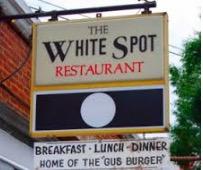
If you are a UVA alumnus, or have spent time in Charlottesville, Virginia, this article will almost certainly evoke a response. Depending on your mindset regarding diet, the response could be “Yum!,” “Gross!,” or “How can I possibly still be alive?” Drooling is not uncommon.
The Gus Burger is a Charlottesville legend, and as with all legends, there is a story behind it, true or false. This one is true. The White Spot (1), which has been around for more than 50 years (no one really knows when it opened) is an 11-stool hole in the wall right across from the campus. It is extremely popular, especially for impoverished grad students (2). In 1975, you could get a Gus Burger, fries and a Coke for $1.50. Tip optional.

According to lore, many years ago a man named Gus (what are the chances?) would visit the place every day and order the same thing—a cheeseburger with a fried egg on top, hence the name, which has endured for more than 50 years. Gus Burgers made up roughly 90 percent of my dinners in grad school, yet I still exist above ground. How can this be? Possibly because what is considered healthy changes constantly. The ingredients of the Gus Burger provide a good example of what we thought we knew about food, only to subsequently find out that it was mostly wrong.
I spoke with American Council advisor Dr. David Seres, who is the director of medical nutrition, Columbia University Medical Center, NYPresbyterian Hospital. He is not shy about expressing his opinions on fad diets and ever-changing food recommendations.
"Anyone paying attention is no longer surprised by the latest outlandish diet claim, or that we've once again changed our minds about what is healthy to eat. Unfortunately, enough people are susceptible to snake oil that this behavior just persists. The low carb diet was first proposed by William Banting in the 1880's. This stuff cycles in and out because we really don't know how to counsel people. But it isn't just the nutritional quacks. Scientists fill in with opinion, which is wrong more often than right, instead of saying 'we don't know."'
Dr. David Seres
Let's see what he has to say about the ingredients in "the Gus."
- Bun: Carbohydrates were “healthy” in the 1990s, but fat and cholesterol were not. This resulted in what was called the “Snackwell effect,” from cookies of the same name, which Nabisco introduced in 1992. They were a smash hit. People who wouldn't dare put butter on their toast blithely stuffed their face with the high-sugar low-fat snacks. And who could blame them? USDA advice regarding sugar and fat changed in the course of one decade:
1985—Avoid too much sugar
1995—Choose a diet moderate in sugars
Dr. Seres: "I remember a box of particularly delicious non-fat oatmeal raisin cookies (3) I was halfway through eating and thinking myself virtuous, only to find out that there were at least as many calories in them as the originals."

Seriously?
- Egg: Eggs were the “bad eggs” of dietary science because the yolk contains cholesterol, and you sure didn't want to eat any of that because your heart would stop halfway through the omelet. Except this was also wrong. Dietary cholesterol is only a small contributor to the total amount in your body. This is because 80 percent of your total cholesterol is made in the liver. Cutting your dietary intake in half has a minimal impact at best. Eggs are now generally considered to be healthy. however, the yolks do contain about 5 grams of fat.
- Meat and cheese (fat): Good and bad oils and fat seem to trade places every week. This is because no one really knows what is good and what is bad. The health benefits of the oft-criticized saturated fats are either better, worse, or equal than those of polyunsaturated fats, which have traditionally been considered to be healthy.
"We’ve been fed a lot of fat-laden advice without proper research, and now we’ve realized some of the harm. For example, we’re frantically trying to remove trans fats from the food supply. These were added to recreate the textures we used to get from saturated fats in our processed foods."
- Tomato (beta-carotene, antioxidant): "The beta-carotene antioxidant claim is nonsense. Not only have antioxidant supplements not proven to decrease any disease, there is credible data from large randomized studies they may increase the incidence of cancers. Just go to the National Cancer Institute and search for vitamin E and prostate cancer."
Lettuce: Takes up space. Lettuce move on.
And the news just keeps getting better. In case the Gus Burger didn't fill you up, another the U Caff, on the same street, served another Charlottesville classic called the Grillswith—which consists of two fried glazed donuts with vanilla ice cream on top. The ice cream is supposedly optional, except that it is found on top of the donuts whether you order it or not. Sadly U Caff no longer exists.
Bon appétit.
Notes:
(1) The “White Spot” name comes from the fact that the place used to be a barber shop. When the barber chair was removed, it left an untiled spot. White paint was applied — hence the restaurant's name.
(2) Before you judge, you try living on $282 per month.
(3) Around this same time, companies started marketing anything that contained oats as cholesterol-lowering, even though the effect is modest.



